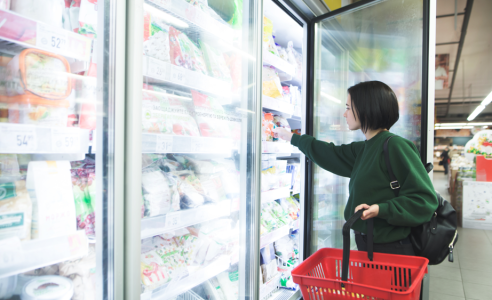Feeling cold at the grocery store? Discover the shocking cause of the 'Arctic aisle effect' – it's not what you think!
By
- Replies 6
As you reach for your favourite yogurt or a fresh cut of meat at your local supermarket, you might notice a sudden chill that makes you shiver. It's a common experience for shoppers, especially during the winter months, and it's known as the 'arctic aisle effect'. But have you ever wondered why it feels like you've stepped into a freezer when walking down certain supermarket aisles?
The phenomenon is not just your imagination. In fact, the air temperature in Australian supermarkets can often be as cold as the wintry conditions outside. For instance, the meat aisle of one Sydney Aldi store was recorded at a chilly 13.1 degrees this week. This cold environment is the result of rows of open fridges housing chilled products like meat and dairy, which create flows of cold air that circulate around the store, prompting customers to bundle up in their winter woollies.
While the 'big three' supermarket chains – Woolworths, Coles, and Aldi – have recently made some efforts to address this issue and increase energy efficiency, it's intriguing to consider why they may have been slow to act. According to Jana Bowden, a professor of marketing and consumer psychology at Macquarie University's business school, supermarkets have traditionally used fan technology to distribute cold air throughout their stores to even out the temperature. However, this method isn't always effective, and customers can still find themselves in aisles with temperatures as low as 7-10 degrees.
Interestingly, the cold temperatures could inadvertently be influencing our shopping habits in a way that boosts supermarket profits. Professor Bowden suggests that a bit of chill might be 'good chill' for the stores. Research indicates that when consumers are slightly cooler while shopping, their decision-making tends to become more emotionally driven rather than rational, which can lead to increased spending.
Professor Nitika Garg from the University of NSW Business School has researched how weather impacts people's preferences for unhealthy foods. She found that during bad weather conditions – when it's cold or rainy – people tend to gravitate towards comfort or 'hedonic' foods, such as chocolate. While it's unlikely that supermarkets are intentionally keeping temperatures low to increase spending at the checkout, this could be a fortuitous side-effect for them.
However, there's a delicate balance to maintain. If supermarkets allow temperatures to drop too low, they risk deterring customers altogether. Bowden warns that if shoppers feel 'frozen solid', there's a clear negative effect: cold consumers mean reduced dwell time in front of shelves and decreased spending as they rush to leave the uncomfortable environment.
So, which supermarkets are the coldest? A recent investigation by 9news.com.au measured the temperatures inside random Woolworths, Aldi, and Coles stores in Sydney. Aldi's Thornleigh store was the coldest, with the meat and dairy aisle at 13.1 degrees. In contrast, the Coles store in North Sydney, which had recently added doors to most refrigerated sections, maintained a more consistent temperature of around 17.1 degrees.
Supermarkets are taking note and making changes. Aldi is trialling the addition of chiller doors in 20 stores across various states, and Woolworths has been fitting doors on fridges in new and renovated stores since 2015, which can cut electricity consumption by up to 30 per cent. All of Aldi's Australian operations are powered by 100 per cent renewable energy, and both Coles and Woolworths have committed to achieving the same by 2025.

Next time you're shopping and feel the cold, remember that it's not just about keeping the food fresh – it could also be subtly influencing your shopping choices. And if you're someone who prefers a warmer shopping experience, you might want to look out for stores that have taken steps to moderate their temperatures. It's a small comfort that could make your grocery run a little more pleasant and perhaps even a bit healthier for your wallet and your waistline.
The phenomenon is not just your imagination. In fact, the air temperature in Australian supermarkets can often be as cold as the wintry conditions outside. For instance, the meat aisle of one Sydney Aldi store was recorded at a chilly 13.1 degrees this week. This cold environment is the result of rows of open fridges housing chilled products like meat and dairy, which create flows of cold air that circulate around the store, prompting customers to bundle up in their winter woollies.
While the 'big three' supermarket chains – Woolworths, Coles, and Aldi – have recently made some efforts to address this issue and increase energy efficiency, it's intriguing to consider why they may have been slow to act. According to Jana Bowden, a professor of marketing and consumer psychology at Macquarie University's business school, supermarkets have traditionally used fan technology to distribute cold air throughout their stores to even out the temperature. However, this method isn't always effective, and customers can still find themselves in aisles with temperatures as low as 7-10 degrees.
Interestingly, the cold temperatures could inadvertently be influencing our shopping habits in a way that boosts supermarket profits. Professor Bowden suggests that a bit of chill might be 'good chill' for the stores. Research indicates that when consumers are slightly cooler while shopping, their decision-making tends to become more emotionally driven rather than rational, which can lead to increased spending.
Professor Nitika Garg from the University of NSW Business School has researched how weather impacts people's preferences for unhealthy foods. She found that during bad weather conditions – when it's cold or rainy – people tend to gravitate towards comfort or 'hedonic' foods, such as chocolate. While it's unlikely that supermarkets are intentionally keeping temperatures low to increase spending at the checkout, this could be a fortuitous side-effect for them.
However, there's a delicate balance to maintain. If supermarkets allow temperatures to drop too low, they risk deterring customers altogether. Bowden warns that if shoppers feel 'frozen solid', there's a clear negative effect: cold consumers mean reduced dwell time in front of shelves and decreased spending as they rush to leave the uncomfortable environment.
So, which supermarkets are the coldest? A recent investigation by 9news.com.au measured the temperatures inside random Woolworths, Aldi, and Coles stores in Sydney. Aldi's Thornleigh store was the coldest, with the meat and dairy aisle at 13.1 degrees. In contrast, the Coles store in North Sydney, which had recently added doors to most refrigerated sections, maintained a more consistent temperature of around 17.1 degrees.
Supermarkets are taking note and making changes. Aldi is trialling the addition of chiller doors in 20 stores across various states, and Woolworths has been fitting doors on fridges in new and renovated stores since 2015, which can cut electricity consumption by up to 30 per cent. All of Aldi's Australian operations are powered by 100 per cent renewable energy, and both Coles and Woolworths have committed to achieving the same by 2025.
Key Takeaways
- Many customers find Australian supermarkets cold, particularly along the aisles with open refrigeration, a phenomenon known as the 'arctic aisle effect'.
- Supermarkets like Aldi, Coles, and Woolworths have been slow to install doors on fridges for various reasons, including impacts on consumer behaviour and energy efficiency strategies.
- Aldi has started trialling the addition of doors to its fridges in several stores to increase energy efficiency, with plans to expand this trial.
- Both Coles and Woolworths are also incorporating doors on refrigeration units in new and renovated stores to cut down on energy consumption, with all new Coles stores having fridges with doors, reducing refrigeration energy consumption by over 20 per cent. Woolworths noted that the introduction of doors on fridges could cut electricity consumption by up to 30 per cent.
Next time you're shopping and feel the cold, remember that it's not just about keeping the food fresh – it could also be subtly influencing your shopping choices. And if you're someone who prefers a warmer shopping experience, you might want to look out for stores that have taken steps to moderate their temperatures. It's a small comfort that could make your grocery run a little more pleasant and perhaps even a bit healthier for your wallet and your waistline.








